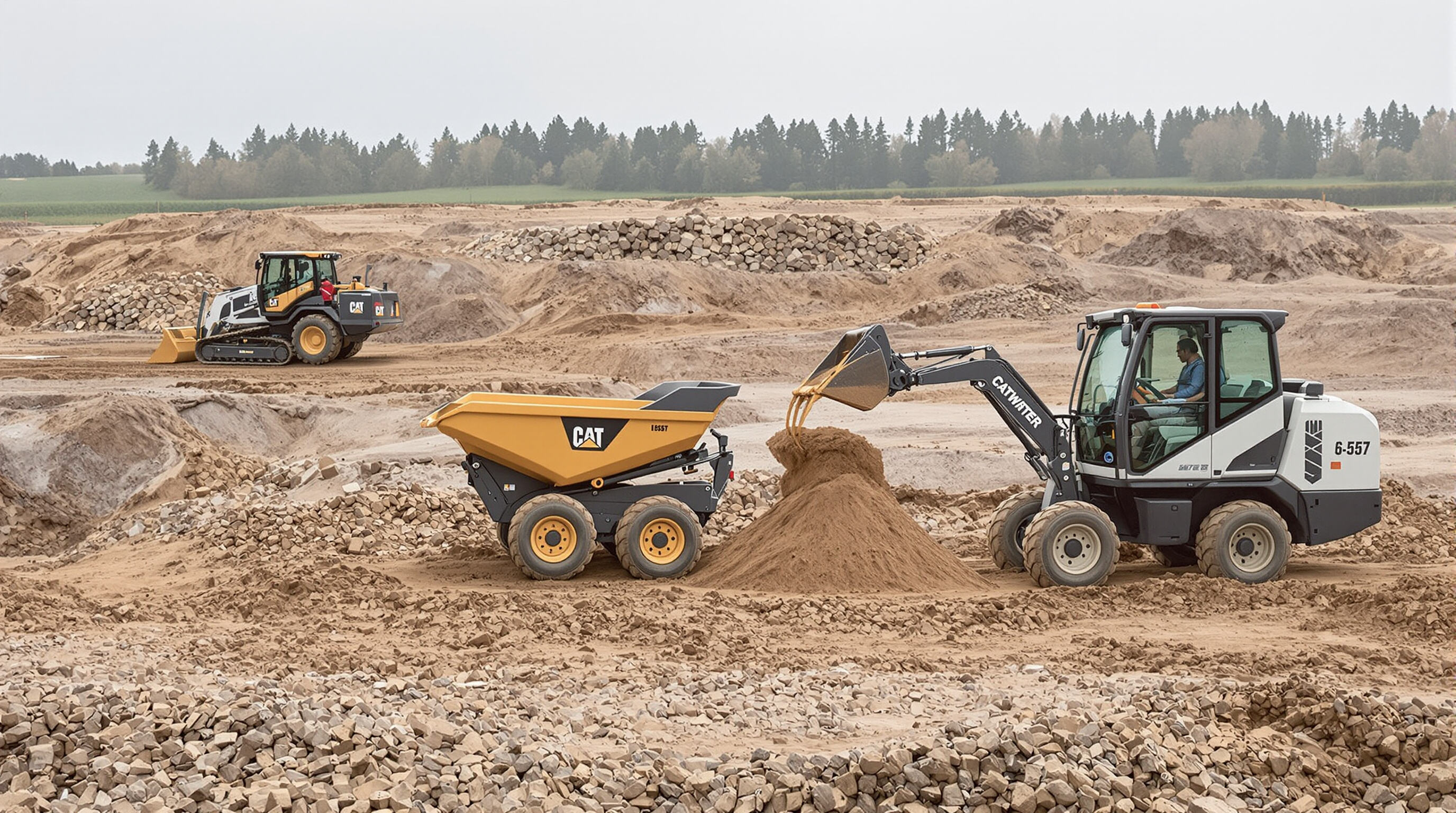معتمد على الغاز المُجَمِّعات الصغيرة الكهربائية القوة، والتحمل، والأداء الميداني
عزم دوران عالي واستمرارية التشغيل تحت الظروف الصعبة
تعمل المُجَرّات الصغيرة بالغاز على توفير عزم دوران كبير، مما يعني أنها قادرة على تسلق المنحدرات الشديدة وجر الأحمال الثقيلة التي قد تتسبب في تعطيل الآلات الأصغر. تواصل المحركات ذات الاحتراق الداخلي العمل بقوة طوال أيام العمل الطويلة، وهو أمر بالغ الأهمية عند العمل في مواقع البناء الكبيرة أو المناطق النائية التي لا تتوافر فيها منافذ شحن. يعرف المشغلون ذلك جيدًا، إذ لا تفقد هذه النماذج التي تعمل بالغاز قوتها كما هو الحال مع النماذج الكهربائية عند مواجهة الظروف الصعبة. فهي تؤدي بشكل موثوق حتى في الحفر الطينية وعلى الطرق الوعرة الصخرية، دون الشعور بهذا الانخفاض التدريجي في القوة الذي يلاحظه البعض في المعدات التي تعمل بالبطاريات بعد الاستخدام لفترة طويلة.
كفاءة استهلاك الوقود ومدى التشغيل لأنجح النماذج التي تعمل بالغاز
أجهزة التي تعمل بالغاز هذه الأيام توفر كفاءة جيدة في الاستهلاك بفضل أنظمة التحكم الذكية في المحرك، مع تشغيل بعض الموديلات الرائدة لمدة تتراوح بين 8 إلى 10 ساعات بخزان وقود واحد. هذه المدة الإضافية مهمة للغاية عند العمل بعيدًا عن مصادر الطاقة، حيث لا داعي للانتظار لشحن البطاريات. معظم الأشخاص الذين يعملون في المواقع يقدرون مدى سرعة إعادة تعبئة الخزانات، ويجدون محطات الوقود في كل مكان تقريبًا، مما يحافظ على استمرارية العمليات دون تلك الانقطاعات المزعجة التي نكرهها جميعًا في أوقات المواعيد النهائية الضيقة.
دراسة حالة: الاستخدام الشاق في مشروع بنية تحتية ريفية نائية
م roadway تطوير الطرق الجبلية لعام 2023 في كولورادو يُظهر قدرات المكبسات الصغيرة التي تعمل بالغاز. خلال ستة أسابيع، نقلت ثلاث وحدات أكثر من 500 طن من المواد يوميًا عبر تضاريس صخرية غير ممهدة على ارتفاع 8000 قدم. رغم الظروف القاسية في درجات الحرارة والمرافق المدعمة المحدودة، حافظت هذه الوحدات على 98٪ من وقت التشغيل—مُظهِرة موثوقية حاسمة في أماكن يواجه فيها النموذج الكهربائي قيودًا في الشحن.
تكاليف الصيانة والتشغيل على المدى الطويل للوحدات التي تعمل بالغاز
على الرغم من أنها تتطلب صيانة أكثر تكرارًا مقارنة بجرارات التفريغ الصغيرة الكهربائية، إلا أن نماذج الوقود تعوّض التكاليف من خلال البساطة الميكانيكية ومكونات يمكن إصلاحها في الميدان. تُظهر بيانات الصناعة تقسيمًا نموذجيًا لملكية 3 سنوات:
| المكون التكاليفي | نسبة من المجموع | ملاحظات |
|---|---|---|
| وقود | 60% | استنادًا إلى 1200 ساعة تشغيل سنوية |
| قطع الغيار/العمالة | 30% | فلاتر، شمعات الإشعال، تغيير السوائل |
| الاهتلاك | 10% | قيمة متبقية أعلى في المناطق النائية |
يجعل هذا الملف التكلفة الوحدات التي تعمل بالغاز مجدية اقتصاديًا للمشاريع التي تُولِي أولوية للتحمل على حساسية الانبعاثات، خاصة في المناطق التي يقتصر فيها الوصول إلى الكهرباء.
جرار التفريغ الكهربائي مقابل الذي يعمل بالغاز: مقارنة مباشرة

الطاقة الناتجة والسعة الحمولة: سد الفجوة في الأداء
تستطيع الشاحنات القلابة الكهربائية الصغيرة هذه الأيام إنتاج حوالي 80% من عزم الدوران الذي توفره طرازات البنزين، مما ساهم في تقليص فارق الأداء بشكل كبير بفضل التحسينات في تقنية المحركات. لا تزال طرازات البنزين تتمتع ببعض المزايا عند رفع الأحمال الثقيلة - فهي عادةً ما تتحمل حوالي 1500 رطل مقارنةً بـ 1200 رطل فقط لنظيراتها الكهربائية. ولكن لا تستبعد الشاحنات الكهربائية تمامًا. فهي تعوّض عن ذلك باستجابة فورية لعزم الدوران، مما يُسهّل نقل المواد بشكل كبير في العمليات اليومية، وفقًا لتقارير الصناعة الصادرة عن شركة Green Machinery في عام 2023.
مستويات الضجيج والسلامة في بيئات العمل المشتركة أو الحضرية
تعمل النماذج الكهربائية بمستوى ضجيج 65 ديسيبل - ما يعادل حديثاً عادياً - مقارنةً بـ 95 ديسيبل في الوحدات التي تعمل بالغاز، وهو ما يتوافق مع اللوائح الصارمة المتعلقة بالضجيج في المناطق الحضرية. يؤدي هذا التخفيض البالغ 30 ديسيبل إلى تقليل الحاجة لمعدات حماية السمع وتحسين التواصل في مواقع العمل، وخاصةً في المناطق السكنية (OSHA 2022).
التأثير البيئي: مقارنة الانبعاثات والاستدامة
تمنع المكبات الكهربائية الصغيرة الانبعاثات المباشرة، مما يمنع 4.8 طن من إخراج ثاني أكسيد الكربون سنويًا لكل آلة مقارنة بالنموذج الغازي. عند تشغيلها بالطاقة المتجددة، تنخفض البصمة الكربونية مدى الحياة بنسبة 72٪، وهو ما يتماشى مع أهداف الاستدامة المؤسسية (التحالف التكنولوجي النظيف 2023).
إجمالي تكلفة الملكية على مدى 3 سنوات: تحليل مدخرات المكبات الكهربائية الصغيرة
على الرغم من التكاليف الأولية الأعلى، إلا أن النماذج الكهربائية توفر تكلفة ملكية أقل بنسبة 35٪ على مدى ثلاث سنوات (18700 دولار مقابل 28900 دولار للنماذج الغازية). تأتي المدخرات من صيانة مخفضة (لا حاجة لتغيير الزيت أو استبدال شمعات الإشعال) وتكاليف طاقة أقل بنسبة 85٪ (مجلة كفاءة البناء 2024).
متى يجب اختيار مكبس كهربائي صغير بناءً على ظروف الموقع
المساحات الداخلية والمضيقة التي تتميز بها المعدات الكهربائية
عندما يتعلق الأمر بالعمل في مناطق مزدحمة مثل المستودعات أو القبو أو تلك الأماكن السكنية الصعبة التي تكون المساحة فيها محدودة للغاية، فإن الماكينات الصغيرة الكهربائية لتفريغ الحمولة تتفوق حقًا مقارنة بالإصدارات التي تعمل بالغاز. لا تطلق هذه الماكينات أي عوادم، لذا لا داعي للقلق بشأن أنظمة التهوية أو مشكلات جودة الهواء داخل المباني. ويجعلها ذلك خيارًا مثاليًا للعمل الداخلي حيث تكون أهمية الهواء النقي في ذروتها. إن نصف قطر الدوران الصغير لهذه الماكينات المدمجة يعني أنها قادرة على التنقل بسهولة عبر الزوايا الضيقة والالتفاف حول العقبات. بالإضافة إلى ذلك، تعمل بصمت دون تجاوز 65 ديسيبل، مما يجعلها مناسبة تمامًا للأماكن التي قد يكون الضجيج فيها مشكلة، كالمستشفيات خلال الورديات الليلية أو المباني المكتبية أثناء محاولة الموظفين التركيز على مهام هامة.
المشاريع الحضرية التي تخضع لتشريعات الضجيج والانبعاثات
لقد فرضت مدينتا نيويورك ولوس أنجلوس قواعد صارمة فيما يتعلق مواقع البناء في الآونة الأخيرة. وتشترط هذه القواعد مستويات ضجيج أقل من 72 ديسيبل وعدم وجود أي انبعاثات عادم من الآلات العاملة في الموقع. تتوافق الشاحنات الكهربائية الصغيرة لتفريغ الحمولة مع جميع هذه الشروط بشكل تلقائي، مما يوفر على المقاولين مئات الدولارات يوميًا من الغرامات المحتملة التي تُفرض عندما تُخفق الآلات التقليدية التي تعمل بالبنزين في اجتياز الفحوصات. وقد أظهرت دراسة حديثة أن الفرق التي انتقلت إلى استخدام النماذج الكهربائية في مهام مثل إصلاح الأرصفة أو ترقية المرافق المحيطة بالمدارس شهدت تقلصًا في أوقات انتظار التصاريح بنسبة تصل إلى 40 بالمائة وفقًا لتقرير الكفاءة في البناء الحضري الذي نُشر السنة الماضية. وهذا منطقي بالفعل، إذ أن السلطات المحلية تميل إلى تسريع إنجاز المشاريع التي تسبب اضطرابًا أقل للمجتمعات المحيطة.
التطبيقات التي تركز على راحة المشغل وصيانة محدودة إلى أدنى حد
تقلل الآلات الكهربائية من إرهاق المشغلين لأنها تهتز بنسبة تصل إلى نصف ما تهتز به نظيراتها التي تعمل بالغاز وفقًا لمعايير ISO 2631 لعام 2023. كما أن عدم الحاجة إلى تغييرات دورية لزيت المحرك أو استبدال شمعات الإشعال أو تنظيف فلاتر الوقود يعني أن تكاليف الصيانة تكون عادة حوالي 120 دولارًا سنويًا مقارنة بأكثر من 450 دولارًا للآلات التي تعمل بالبنزين. هذا الفرق يصبح مهمًا جدًا عند العمل في نوبات متعددة. ففي دنفر، شهد المقاولون الذين انتقلوا إلى المُنشآت الصغيرة الكهربائية تقلصًا في الأعطال المفاجئة بنسبة تصل إلى 89 بالمئة أثناء العمل في مشروع بناء وسط المدينة استمر ستة أشهر العام الماضي.
الحالات التي لا تزال فيها المنشآت الصغيرة التي تعمل بالبنزين هي المسيطرة

المواقع النائية أو خارج الشبكة الكهربائية مع بنية تحتية محدودة لشحن البطاريات
بالنسبة للأعمال في المواقع النائية حيث لا يتوفر الطاقة بشكل دائم، لا يمكن التفوق على معدات التفريغ الصغيرة التي تعمل بالبنزين. تحتاج الإصدارات الكهربائية إلى شحن مستمر، وهو أمر غير عملي عند عدم وجود اتصال بشبكة الكهرباء. تواصل هذه الموديلات البنزينية العمل طالما كان هناك وقود في الخزان، مما يجعلها أداة حقيقية ذات قيمة في الأماكن مثل الغابات والمناجم والمناطق الريفية النامية. وبحسب بحث أجرته معهد المعدات الإنشائية في عام 2023، يختار ثلاثة أرباع المقاولين تقريبًا محركات البنزين لأعمالهم خارج الموقع، حيث لا داعي للقلق بشأن نفاد بطارية في منتصف المهمة، ويظل العمل أبسط دون الحاجة إلى إدارة جميع متطلبات الشحن.
الأداء الثقيل والمستمر في التضاريس الوعرة
تتميز الآلات التي تعمل بالغاز حقًا عندما يتعلق الأمر بالمواقف الصعبة التي لا يرغب أحد في مواجهتها: التلال الشديدة الانحدار، والمستنقعات الطينية، والصخور الوعرة. فهي ببساطة تعمل بشكل أفضل من النسخ الكهربائية لأنها توفر عزم دوران أعلى ولها أنظمة هيدروليكية مريحة جاهزة للاستخدام. كما أن النظام بأكمله أبسط من الناحية الميكانيكية، لذا فإن هذه الآلات تواصل العمل حتى في ظل درجات حرارة مرتفعة أو منخفضة للغاية، أو عندما يبدأ الغبار بالتطاير في كل مكان وهو ما تكرهه البطاريات. انظر إلى ما يحدث في الموقع. يمكن لآلة تفريغ صغيرة تعمل بالغاز وبنظام دفع رباعي التعامل مع أكثر من 1100 رطلاً من التربة أو الحصى أو أي شيء يحتاج إلى نقل عبر أرضيات وعرة بكل سهولة دون أي تباطؤ.
الأداء في الطقس البارد: ميزة الغاز في المناخات دون الصفر المئوي
تستمر المحركات الغازية في إنتاج طاقة ثابتة حتى عندما تنخفض درجات الحرارة إلى أقل من -20 درجة فهرنهايت (-29 درجة مئوية)، لكن بطاريات الليثيوم أيون الموجودة داخل تلك الماكينات الكهربائية الصغيرة تفقد حوالي 40٪ من سعتها بمجرد أن تصبح درجات الحرارة شديدة البرودة وفقًا لتقرير نُشر في مجلة Energy Storage Journal العام الماضي. هذا النوع من الأداء الموثوق به يفسر سبب استمرار الناس في استخدام الماكينات التي تعمل بالغاز أثناء مشاريع البناء في الشتاء، وإزالة الثلج من الطرق، أو العمل في الارتفاعات التي يكون فيها التشغيل السريع أمرًا مهمًا جدًا، ولا يمكن التفريط في توفر كامل القدرة بشكل فوري.
الاعتبارات الرئيسية التي تُعزز هيمنة الماكينات التي تعمل بالغاز:
- متوسط 8–12 ساعة من التشغيل المستمر لكل خزان وقود
- 30٪ أسرع في إعادة التزود بالوقود مقارنةً بتبديل البطاريات الكهربائية
- لا تعتمد على الاستثمارات في البنية التحتية للشحن
تستمر المشاريع التي تتطلب هذه الظروف التشغيلية المتطرفة في الاعتماد على الماكينات الصغيرة التي تعمل بالغاز رغم الاعتماد المتزايد على البدائل الكهربائية في المناطق الحضرية.
الأسئلة الشائعة (FAQ)
كم تبلغ مدة تشغيل الماكينات الصغيرة التي تعمل بالغاز على خزان وقود واحد؟
يمكن للماكينات الصغيرة التي تعمل بالغاز أن تعمل من 8 إلى 12 ساعة بخزان وقود واحد، ويعتمد ذلك على الموديل وظروف الاستخدام.
هل الماكينات الصغيرة التي تعمل بالغاز أكثر ملاءمة للمناخات الباردة؟
نعم، تعمل الماكينات الصغيرة التي تعمل بالغاز بشكل أفضل في المناخات الباردة حيث تحافظ على القوة حتى عندما تنخفض درجات الحرارة، على عكس الموديلات الكهربائية التي تفقد سعة البطارية في الظروف الباردة.
ما هي تكاليف الصيانة الأساسية للماكينات الصغيرة التي تعمل بالغاز؟
تشمل تكاليف الصيانة الرئيسية الوقود بنسبة 60٪ من إجمالي المصروفات، تليها قطع الغيار والعمالة بنسبة 30٪ للعناصر التي تُحافظ عليها بشكل دوري مثل الفلاتر والشمعات.
هل الماكينات الصغيرة الكهربائية توفر فوائد بيئية؟
توفر الماكينات الصغيرة الكهربائية فوائد بيئية من خلال القضاء على الانبعاثات المباشرة وتقليل البصمة الكربونية بشكل كبير، خاصة عندما تعمل بواسطة مصادر طاقة متجددة.

